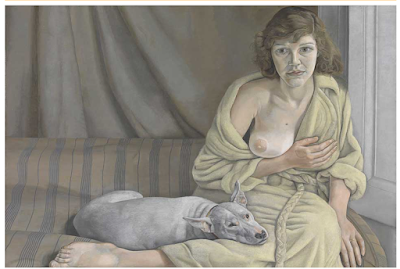 |
| Lucian
Freud (British, born Germany, 1922 - 2011), Girl with a White Dog, 1950
- 1951. Oil on canvas Dimensions: Unframed: 76.2 × 101.6 cm (30 × 40
in.) Framed: 95.4 × 120 × 9.2 cm (37 9/16 × 47 1/4 × 3 5/8 in.)
Accession No. EX.2016.3.63 Object Credit: Tate: Purchased 1952 Repro
Credit: Photo © Tate, London 2016. |
From the 1940s through the 1980s, a prominent group of London based artists developed new styles and approaches to depicting the human figure and the landscape. These painters resisted the abstraction, minimalism, and conceptualism that dominated contemporary art at the time, instead focusing on depicting contemporary life through innovative figurative works. On view at the
J. Paul Getty Museum from July 26 to November 13, 2016, "London Calling," with works drawing primarily from the collections of the Tate Museum, includes works by Franis Bacon, Freud, Kossof f , Andrews, Auerbach, and Kitaj. The show at the Getty represents the first major American museum exhibition to explore the leaders of this movement, often called the “School of London,” as central to a richer and more complex understanding of 20th century painting.
 |
| The Wedding, 1989–93, R.B. Kitaj, oil on canvas. Tate: Presented by the artist 1993. Photo © Tate, London 2016. Artwork © R.B. Kitaj Estate, courtesy Marlborough Fine Art |
The exhibition includes 80 paintings, drawings, and prints by Francis Bacon, Lucian Freud, Leon Kossoff, Michael Andrews, Frank Auerbach, and R.B. Kitaj.
Amazingly enough, you can take
photos!
Co-curator Julian Brooks added, "They were working in an unfashionable style when all the artists around them were promoting abstract expressionism and conceptual art. But they took the old school methods and pushed them one step further."
While called the “School of London” after a Kitaj described their style in a 1976 exhibition catalog, there was no “School.” The label referred to a group of artists (more than presented here) in austere, post-World War II London who rejected the minimalism, pop art and conceptual directions other artists were moving toward; instead, they carved a niche building on traditional styles with dramatic looks at their damaged surroundings and the people near by.





